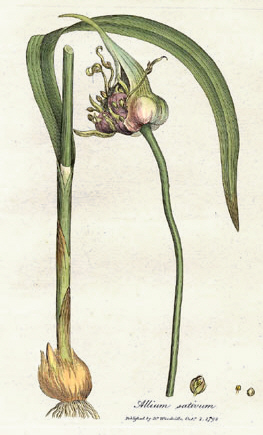
Chives, scientific name Allium schoenoprasum, is a species of flowering plant in the family Amaryllidaceae that produces edible leaves and flowers. Their close relatives include the common onions, garlic, shallot, leek, scallion, and Chinese onion.

An onion, also known as the bulb onion or common onion, is a vegetable that is the most widely cultivated species of the genus Allium. The shallot is a botanical variety of the onion which was classified as a separate species until 2011. Its close relatives include garlic, scallion, leek, and chive.

Allium ursinum, known as wild garlic, ramsons, cowleekes, cows's leek, cowleek, buckrams, broad-leaved garlic, wood garlic, bear leek, Eurasian wild garlic or bear's garlic, is a bulbous perennial flowering plant in the amaryllis family Amaryllidaceae. It is native to Europe and Asia, where it grows in moist woodland. It is a wild relative of onion and garlic, all belonging to the same genus, Allium. There are two recognized subspecies: A. ursinum subsp. ursinum and A. ursinum subsp. ucrainicum.

Allium tricoccum is a North American species of wild onion or garlic widespread across eastern Canada and the eastern United States. Many of the common English names for this plant are also used for other Allium species, particularly the similar Allium ursinum, which is native to Europe and Asia.

Allium vineale is a perennial, bulb-forming species of wild onion, native to Europe, northwestern Africa and the Middle East. The species was introduced in Australia and North America, where it has become a noxious weed.

Allium drummondii, also known as Drummond's onion, wild garlic and prairie onion, is a North American species of onion native to the southern Great Plains of North America. It is found in South Dakota, Kansas, Nebraska, Colorado, Oklahoma, Arkansas, Texas, New Mexico, and northeastern Mexico.

Allium canadense, the Canada onion, Canadian garlic, wild garlic, meadow garlic and wild onion is a perennial plant native to eastern North America from Texas to Florida to New Brunswick to Montana. The species is also cultivated in other regions as an ornamental and as a garden culinary herb. The plant is also reportedly naturalized in Cuba.

Allium ampeloprasum is a member of the onion genus Allium. The wild plant is commonly known as wild leek or broadleaf wild leek. Its native range is southern Europe to western Asia, but it is cultivated in many other places and has become naturalized in many countries.

Stillingia is a plant genus of the family Euphorbiaceae, first described for modern science as a genus in 1767. The genus is native to Latin America, the southern United States, and various islands in the Pacific and Indian Oceans. Toothleaf is a common name for plants in this genus.

Hippomane is a genus of plants in the Euphorbiaceae described by Linnaeus in 1753. It is native to the West Indies, Central America, Mexico, Florida, Venezuela, Colombia, and Galápagos.

Allium cernuum, known as nodding onion or lady's leek, is a perennial plant in the genus Allium. It grows in open areas in North America.

Allium textile is a common species of wild onion found in the central part of North America.

Sapium glandulosum is a species of tree in the family Euphorbiaceae. It is native to the Neotropics from Mexico and the Caribbean south to Argentina, and it has been cultivated elsewhere. It is the most common Sapium species. Its common names include gumtree, milktree, leche de olivo, and olivo macho.

Allium yosemitense is a California species of wild onion known by the common name Yosemite onion. Most of the known populations are situated within the boundaries of Yosemite National Park.

Allium stellatum, commonly known as the autumn onion, prairie onion, cliff onion, or glade onion, is a North American species of wild onion in the Amaryllidaceae family that is native to central Canada and the central United States.

Allium bisceptrum, also known as the twincrest onion or aspen onion, is a high elevation plant native to western United States. It is a perennial that thrives under damp and shady conditions or open meadows in California, Arizona, New Mexico, Nevada, Oregon, Washington, Idaho, and Utah.

Allium victorialis, commonly known as victory onion, Alpine leek, and Alpine broad-leaf allium is a broad-leaved Eurasian species of wild onion. It is a perennial of the Amaryllis family that occurs widely in mountainous regions of Europe and parts of Asia.
Allium rhizomatum is a species of plant native to southern Arizona, southern New Mexico and western Texas in the United States, and Chihuahua in Mexico. It is generally found in dry, grassy areas at elevations of 1200–2200 m. Its common names include spreading wild onion and red flower onion.

Allium is a genus of monocotyledonous flowering plants with hundreds of species, including the cultivated onion, garlic, scallion, shallot, leek, and chives. The generic name Allium is the Latin word for garlic, and the type species for the genus is Allium sativum which means "cultivated garlic".

Erodium glandulosum, called the black-eyed heron's bill, is a species of flowering plant in the genus Erodium, native to the Pyrenees. It has gained the Royal Horticultural Society's Award of Garden Merit.


















